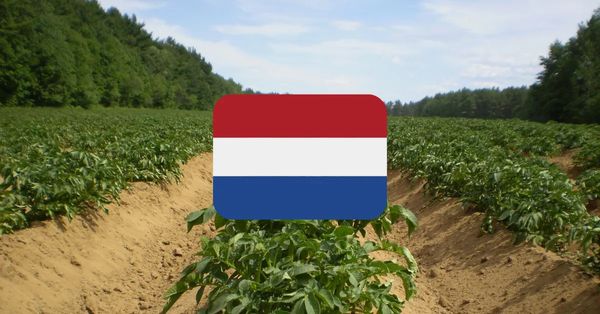.png?fit=outside&w=1200&h=628)
Firing shots at glass greenhouses: Dutch farmers protest
July 15, 2022
In 1989 Netherlands, the four left wing parties merged to form GroenLinks, which translates to GreenLeft. The party’s mission is a better society, one centered on the environment and human rights. According to the group’s online presence, they promote “more freedom and security for all” and work to reduce both pollution and inequality. Theirs, they said, is a Netherlands and Europe that is “greener, more caring and more relaxed.”
The Netherlands, which is only about half the size of Indiana, is a major agricultural exporter, mostly to neighboring countries, primarily Germany but also Belgium, France, and the UK. In 2021, according to research commissioned by the Ministry of Agriculture, Nature and Food Quality, Dutch ag exports were valued at nearly $105 billion, a new record that is significant even attributing some of the nearly 10% growth year over year to the increased prices of exports in addition to the increased volume.
The bulk of Dutch exports are comprised of ornamental horticulture, flowers, bulbs, plants, and tree nursery products. The second most exported ag product is meat, which rose by 7% in 2021.
In 1944, the Dutch government encouraged its citizens who were in the throes of starvation, to forage for acorns and chestnuts. At the end of the war, as the Dutch rebuilt, food security was a priority. According to reporting by Bloomberg, the minister of agriculture at the time, Sicco Mansholt, recognized that the Dutch farms made up of small plots of seasonal crops, small livestock herds, and farmers who served their local community wasn’t a sustainable model if the Dutch were to be equipped to feed themselves. Mansholt drove change that included the consolidation of small farms into larger, more profitable operations through state support.
In 1963, the government created a program to support older farmers as they exited production agriculture and sold their operations to younger producers. The country received financial support from the U.S., quickly increasing the number of tractors in the small country and greatly reducing the farm’s dependence upon labor.
Just as in the U.S., dairy herds grew with the new technology of cooling tanks and milking machines. Greenhouses enabled farmers to grow crops under glass year-round with, in the coastal country that used windmills to remove water from areas, plenty of irrigation water. Add to those conditions inexpensive energy to heat the greenhouses, and Dutch farmers led the world in yield of produce including cucumbers, peppers and tomatoes. Since then, according to the same reporting, Dutch farmers have embraced water conservation practices that make high production efficient and in recent years have vastly reduced their use of synthetic fertilizers and pesticides.
FARMERS PROTEST
This week in the small country, police fired shots at protesting farmers and other farmers used their tractors to spell out “Help! No Farmers No Food!” This follows a ruling by the country’s highest court that claims the Dutch government’s measures to reduce emissions of nitrogen oxide and nitrogen ammonia were out of compliance with EU rules. The farmers, according to reporting by Emma Freire, maintain the government’s proposal to reduce the number of livestock in the country by about one-third will put them out of business, allow government seizure of their land, and will lead to dependance upon food imports.
Freire said protests began prior to 2020 and have reached a boiling point recently after a government report was leaked. The report presented several scenarios, including the forced sale of farms. Christianne van der Wal, cabinet minister for nature and nitrogen said strong measures will be needed to reduce nitrogen emissions.
Dutch farmer protests have blocked supermarket distribution centers, leaving shelves bare, a look into the future should Dutch farmers be forced out of business. Gideon van Meijeren, a far-right member of Parliament told the Dutch Parliament that the nitrogen policy isn’t about nature, but a land grab.
“The cabinet has committed itself to an international Agenda 2030 and executing this requires lots and lots of land. To reach so-called climate goals, thousands of mega wind turbines need to be built by 2030. They also want to build 1 million residences by 2030, for people who are not even in the Netherlands yet. Land is needed for this…. The state does not have it, but the farmers do. Two thirds of the land in the Netherlands is used by the agricultural sector — land that the cabinet has set its sights on.”
According to a white paper by Hans J. M. van Grinsven, et al., Dutch agriculture, including horticulture, contributes 14% to the national emissions of greenhouse gasses (GHG). These emissions hardly decreased since 2000. In the current bid to meet the Paris Climate Agreement, the agricultural sector will need to reduce emissions by 3.5 Mton in 2030. The relative reduction target for GHG by agriculture is 11% and less than the national target of 49%, but still is a challenge because the technical potential for reduction of methane and nitrous oxides is relatively small.
According to the paper, calls from society are driving a reduction in livestock numbers, though experts fear that reducing numbers of Dutch livestock will cause an increase in livestock numbers elsewhere in the EU, called leakage.
As part of the group’s research, they carried out a Life Cycle Analysis for production of milk, pork, poultry, potato, and wheat in other EU countries which disclosed that GHG emission per unit of product in the Netherlands is similar to that in Germany and France, while lower than in central and southern EU. Nitrogen and phosphorus surplus per unit of product for Dutch products often are higher due to the high use of manure.
Most troubling for EU livestock producers, the researchers say such “leakage” could be avoided through “climate policies or when consumption of livestock products would decrease due to increased consumer awareness or targeted interventions.”
Source: Rachel Gabel, The FencePost










